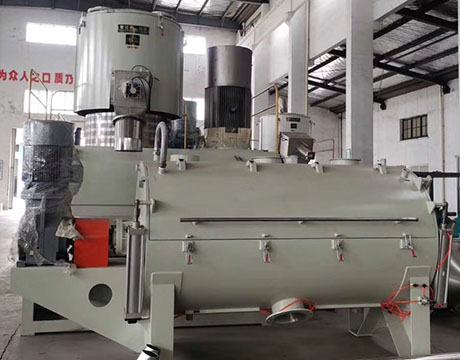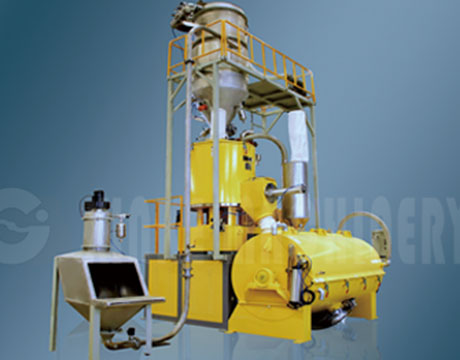Copyright © 2021 Zhangjiagang ChiYu Automation Equipment Co., Ltd. by iwonder.cn All rights reserved. Site Map
In industrial manufacturing, achieving optimal consistency, homogeneity, and efficiency in material processing is essential for product quality and production speed. One specialized piece of equipment that helps manufacturers accomplish these goals is the heating mixer. Whether used in the plastics industry, chemical processing, or food manufacturing, heating mixers combine the functions of blending and thermal processing in one integrated system.
This article explores what a heating mixer is, how it works, its key applications, and what industries benefit most from its use.
A heating mixer, also known as a hot mixer or thermal mixer, is a machine that simultaneously blends and heats materials during the mixing process. Unlike standard mixers, which only agitate materials mechanically, heating mixers introduce controlled heat to alter the physical properties of the materials being processed — such as softening, melting, or initiating chemical reactions.
The machine typically consists of a mixing vessel or tank, equipped with high-speed mixing blades and an integrated heating system. Depending on the application, the heating source can be electric elements, oil jackets, or steam circulation systems.

Heating mixers serve dual purposes:
The primary function of any mixer is to create a uniform mixture from multiple raw materials. High-speed impellers or blades break down clumps, distribute particles evenly, and ensure that all ingredients are consistently blended.
Simultaneously, the heating element raises the temperature of the mixture. This is crucial for applications where ingredients need to reach a specific temperature to change form, activate reactions, or improve binding characteristics. For example, in plastic processing, heat helps resins and additives to fuse uniformly.
By combining these two processes in one machine, heating mixers reduce processing time and eliminate the need for separate heating steps, which improves efficiency and saves space on the production floor.
A typical heating mixer consists of the following components:
Mixing Tank: Usually made of stainless steel or high-grade alloys to withstand pressure, abrasion, and corrosive materials.
Agitator or Mixing Blades: High-speed blades rotate within the vessel to mix the contents thoroughly.
Heating System: Depending on the model, this can be electric heating rods, thermal oil circulation, or steam jackets.
Temperature Control Unit: Enables operators to monitor and adjust the temperature precisely.
Discharge Valve: Allows the processed material to be transferred or emptied efficiently once mixing and heating are complete.
The process starts by loading raw materials into the mixing tank. Once the machine is sealed and started, the agitator begins mixing while the heating system raises the temperature to the set level. Sensors and controllers ensure that both mixing speed and temperature remain within desired parameters throughout the process.
Heating mixers provide several distinct benefits over conventional mixing systems, especially in industrial applications:
● Time Efficiency
Combining heating and mixing reduces the number of steps in the production cycle, which speeds up processing time.
● Improved Product Quality
Controlled heating allows for better solubility, dispersion, and bonding of ingredients, leading to more consistent and high-quality outputs.
● Energy Savings
Integrating thermal processing into the mixer itself reduces the need for separate heating equipment, which can lead to lower energy consumption.
● Reduced Labor and Space Requirements
By eliminating separate heating stages, manufacturers save floor space and reduce manual handling between machines.
● Batch-to-Batch Consistency
Digital controls and automation features help achieve consistent mixing and heating across multiple production batches, which is critical in regulated industries.
Heating mixers are versatile and are widely used in numerous industrial sectors:
● Plastics and Polymer Industry
Heating mixers are essential in the formulation of PVC, PE, and other plastic compounds. They are used to blend resins with stabilizers, pigments, and plasticizers at elevated temperatures to ensure proper dispersion and pre-processing before extrusion or molding.
● Chemicals and Adhesives
In the chemical industry, heating mixers are used for emulsification, reaction processing, and formulation of adhesives, sealants, and lubricants. Heat can be used to accelerate chemical reactions or control viscosity during processing.
● Food Processing
In food manufacturing, heating mixers help in preparing sauces, creams, emulsions, and confectionery. Precise temperature control ensures that ingredients are blended and cooked to exact standards for texture, flavor, and safety.
● Pharmaceuticals and Cosmetics
Heating mixers are widely used in the production of ointments, creams, gels, and lotions where both blending and heating are essential for achieving the correct consistency and stability.
There are several types of heating mixers available, each suited to specific applications:
● High-Speed Heating Mixers
These mixers are used when rapid dispersion and high shear forces are required. They’re common in the plastics industry for powder and granule processing.
● Vacuum Heating Mixers
Vacuum-capable models are used in applications where air must be removed to prevent oxidation or contamination, often found in cosmetic or pharmaceutical production.
● Jacketed Mixers
These mixers include a double-walled jacket around the tank for indirect heating using hot oil, steam, or water. They offer uniform temperature distribution and are suitable for sensitive formulations.
● Planetary Heating Mixers
Designed for viscous materials or pastes, these mixers have multiple rotating blades that revolve on their axes as well as around the mixing vessel.
Selecting the right heating mixer depends on several factors:
Nature of the Materials: Viscosity, reactivity, and thermal sensitivity influence the choice of mixer.
Batch Size and Production Scale: Choose a system that aligns with your throughput requirements.
Heating Method: Depending on precision, speed, and budget, decide between electric, steam, or oil-based heating.
Material of Construction: Ensure compatibility with your ingredients, especially if they are corrosive or abrasive.
Regulatory Compliance: For industries like pharmaceuticals and food, ensure the mixer meets sanitary design standards like GMP or FDA regulations.

As manufacturing becomes increasingly automated and data-driven, heating mixers are evolving to include smart technologies:
IoT Connectivity: Real-time monitoring and control via networked systems.
Predictive Maintenance: Sensor-based systems that alert operators before mechanical failures occur.
Energy Optimization: Advanced controls that adjust heating power based on load and process needs.
Integration with MES and ERP Systems: For seamless operation and traceability across the production chain.
These innovations aim to make heating mixers even more efficient, reliable, and adaptable to changing production demands.
A heating mixer is more than just a blending machine — it is a multifunctional unit designed to improve productivity, product consistency, and processing control across a wide range of industries. By combining mechanical mixing with thermal processing in one integrated system, manufacturers can streamline their operations, reduce waste, and improve output quality.
Whether you're working with polymers, food products, chemicals, or cosmetics, a well-designed heating mixer can make a substantial difference in the success of your production process.